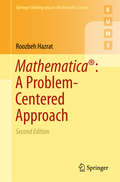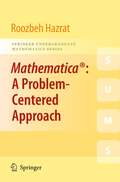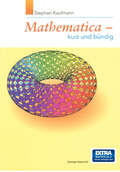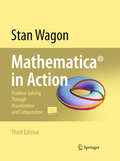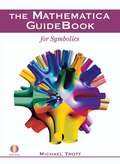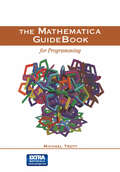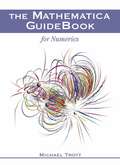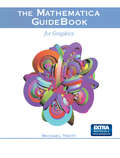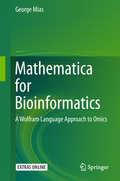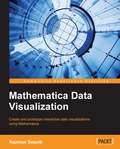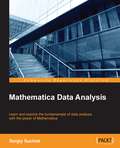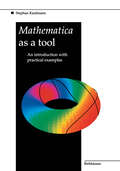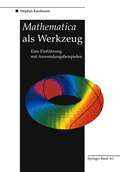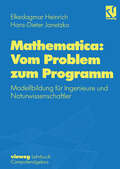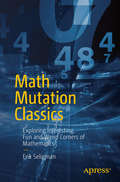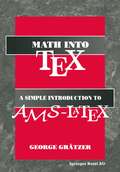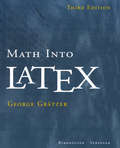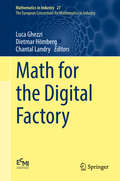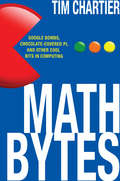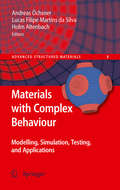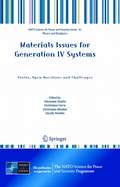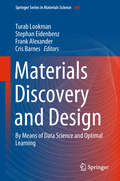- Table View
- List View
Mathematica®: A Problem-Centered Approach (Springer Undergraduate Mathematics Series)
by Roozbeh HazratThis textbook introduces the vast array of features and powerful mathematical functions of Mathematica using a multitude of clearly presented examples and worked-out problems. Each section starts with a description of a new topic and some basic examples. The author then demonstrates the use of new commands through three categories of problems - the first category highlights those essential parts of the text that demonstrate the use of new commands in Mathematica whilst solving each problem presented; - the second comprises problems that further demonstrate the use of commands previously introduced to tackle different situations; and - the third presents more challenging problems for further study. The intention is to enable the reader to learn from the codes, thus avoiding long and exhausting explanations. While based on a computer algebra course taught to undergraduate students of mathematics, science, engineering and finance, the book also includes chapters on calculus and solving equations, and graphics, thus covering all the basic topics in Mathematica. With its strong focus upon programming and problem solving, and an emphasis on using numerical problems that do not need any particular background in mathematics, this book is also ideal for self-study and as an introduction to researchers who wish to use Mathematica as a computational tool.This new edition has been extensively revised and updated, and includes new chapters with problems and worked examples.
Mathematica®: A Problem-Centered Approach (Springer Undergraduate Mathematics Series #53)
by Roozbeh HazratMathematica®: A Problem-Centered Approach introduces the vast array of features and powerful mathematical functions of Mathematica using a multitude of clearly presented examples and worked- out problems. Each section starts with a description of a new topic and some basic examples. The author then demonstrates the use of new commands through three categories of problems - the first category highlights those essential parts of the text that demonstrate the use of new commands in Mathematica whilst solving each problem presented; - the second comprises problems that further demonstrate the use of commands previously introduced to tackle different situations; and - the third presents more challenging problems for further study. The intention is to enable the reader to learn from the codes, thus avoiding long and exhausting explanations. While based on a computer algebra course taught to undergraduate students of mathematics, science, engineering and finance, the book also includes chapters on calculus and solving equations, and graphics, thus covering all the basic topics in Mathematica. With its strong focus upon programming and problem solving, and an emphasis on using numerical problems that do not need any particular background in mathematics, this book is also ideal for self-study and as an introduction to researchers who wish to use Mathematica as a computational tool. Mathematica®: A Problem-Centered Approach comes with a free 30 day trial of the Wolfram Mathematica(R) software'
Mathematica - Kurz und bündig
by Stephan KaufmannMathematica – kurz und bündig ist eine kompakte Einführung in das in der Mathematik sowie in den Natur- und Ingenieurwissenschaften weitverbreitete Programm Mathematica. Die für den Einstieg wesentlichen Aspekte der Version 3 (Front End, Kernel und wichtigste Standard-Pakete) werden mit einfachen, fachunabhängigen Beispielen erläutert und in Übungsaufgaben vertieft. Anschliessend können die Leserinnen und Leser Problemstellungen aus ihrem Fachbereich, eventuell unter Zuhilfenahme der elektronischen Dokumentation, selbständig lösen. Die beigefügte CD-ROM enthält das ganze Buch in Form von Mathematica-Notebooks mit farbigen Versionen der Grafiken und Animationen. In die Notebooks eingebaute Hyperlinks dienen internen Referenzen und verweisen auf die elektronische Dokumentation des Programms und auf Ressourcen im Internet. Die auf Windows 95/98/NT-, Macintosh- und UNIX-Rechnern verwendbare CD-ROM enthält das Programm MathReader, mit welchem die Notebooks auch ohne eine vollständige Mathematica-Installation betrachtet werden können.
Mathematica® in Action: Problem Solving Through Visualization and Computation
by Stan WagonPlenty of examples and case studies utilize Mathematica 7's newest tools, such as dynamic manipulations and adaptive three-dimensional plotting. Emphasizes the breadth of Mathematica and the impressive results of combining techniques from different areas. Whenever possible, the book shows how Mathematica can be used to discover new things. Striking examples include the design of a road on which a square wheel bike can ride, the design of a drill that can drill square holes, and new and surprising formulas for p. Visualization is emphasized throughout, with finely crafted graphics in each chapter.
The Mathematica GuideBook for Symbolics
by Michael TrottProvides reader with working knowledge of Mathematica and key aspects of Mathematica symbolic capabilities, the real heart of Mathematica and the ingredient of the Mathematica software system that makes it so unique and powerful Clear organization, complete topic coverage, and an accessible writing style for both novices and experts Website for book with additional materials: http://www/MathematicaGuideBooks.org Accompanying DVD containing all materials as an electronic book with complete, executable Mathematica 5.1 compatible code and programs, rendered color graphics, and animations
The Mathematica GuideBook for Programming
by Michael TrottThis comprehensive, detailed reference provides readers with both a working knowledge of Mathematica in general and a detailed knowledge of the key aspects needed to create the fastest, shortest, and most elegant implementations possible. It gives users a deeper understanding of Mathematica by instructive implementations, explanations, and examples from a range of disciplines at varying levels of complexity. The three volumes -- Programming, Graphics, and Mathematics, total 3,000 pages and contain more than 15,000 Mathematica inputs, over 1,500 graphics, 4,000+ references, and more than 500 exercises.This first volume begins with the structure of Mathematica expressions, the syntax of Mathematica, its programming, graphic, numeric and symbolic capabilities. It then covers the hierarchical construction of objects out of symbolic expressions, the definition of functions, the recognition of patterns and their efficient application, program flows and program structuring, and the manipulation of lists.An indispensible resource for students, researchers and professionals in mathematics, the sciences, and engineering.
The Mathematica GuideBook for Numerics
by Michael TrottProvides the reader with working knowledge of Mathematica and key aspects of Mathematica's numerical capabilities needed to deal with virtually any "real life" problem Clear organization, complete topic coverage, and an accessible writing style for both novices and experts Website for book with additional materials: http://www.MathematicaGuideBooks.org Accompanying DVD containing all materials as an electronic book with complete, executable Mathematica 5.1 compatible code and programs, rendered color graphics, and animations
The Mathematica GuideBook for Graphics
by Michael TrottThis comprehensive, detailed reference provides readers with both a working knowledge of Mathematica in general and a detailed knowledge of the key aspects needed to create the fastest, shortest, and most elegant implementations possible. It gives users a deeper understanding of Mathematica by instructive implementations, explanations, and examples from a range of disciplines at varying levels of complexity. The three volumes - Programming, Graphics, and Mathematics - each with a CD, total 3,000 pages and contain more than 15,000 Mathematica inputs, over 1,500 graphics, 4,000+ references, and more than 500 exercises.This second volume covers 2 and 3D graphics, providing a detailed treatment of creating images from graphic primitives such as points, lines, and polygons. It also shows how to graphically display functions that are given either analytically or in discrete form and a number of images from the Mathamatica graphics gallery. The use of Mathematicas graphics capabilities provides a very efficient and instructive way to learn how to deal with the structures arising in solving complicated problems.
Mathematica for Bioinformatics: A Wolfram Language Approach to Omics
by George MiasThis book offers a comprehensive introduction to using Mathematica and the Wolfram Language for Bioinformatics. The chapters build gradually from basic concepts and the introduction of the Wolfram Language and coding paradigms in Mathematica, to detailed worked examples derived from typical research applications using Wolfram Language code. The coding examples range from basic sequence analysis, accessing genomic databases, differential gene expression, and machine learning implementations to time series analysis of longitudinal omics experiments, multi-omics integration and building dynamic interactive bioinformatics tools using the Wolfram Language. The topics address the daily bioinformatics needs of a broad audience: experimental users looking to understand and visualize their data, beginner bioinformaticians acquiring coding expertise in providing biological research solutions, and practicing expert bioinformaticians working on omics who wish to expand their toolset to include the Wolfram Language.
Mathematica Data Visualization
by Nazmus SaquibIf you are planning to create data analysis and visualization tools in the context of science, engineering, economics, or social science, then this book is for you. With this book, you will become a visualization expert, in a short time, using Mathematica.
Mathematica Data Analysis
by Sergiy SuchokLearn and explore the fundamentals of data analysis with power of Mathematica About This Book • Use the power of Mathematica to analyze data in your applications • Discover the capabilities of data classification and pattern recognition offered by Mathematica • Use hundreds of algorithms for time series analysis to predict the future Who This Book Is For The book is for those who want to learn to use the power of Mathematica to analyze and process data. Perhaps you are already familiar with data analysis but have never used Mathematica, or you know Mathematica but you are new to data analysis. With the help of this book, you will be able to quickly catch up on the key points for a successful start. What You Will Learn • Import data from different sources to Mathematica • Link external libraries with programs written in Mathematica • Classify data and partition them into clusters • Recognize faces, objects, text, and barcodes • Use Mathematica functions for time series analysis • Use algorithms for statistical data processing • Predict the result based on the observations In Detail There are many algorithms for data analysis and it's not always possible to quickly choose the best one for each case. Implementation of the algorithms takes a lot of time. With the help of Mathematica, you can quickly get a result from the use of a particular method, because this system contains almost all the known algorithms for data analysis. If you are not a programmer but you need to analyze data, this book will show you the capabilities of Mathematica when just few strings of intelligible code help to solve huge tasks from statistical issues to pattern recognition. If you're a programmer, with the help of this book, you will learn how to use the library of algorithms implemented in Mathematica in your programs, as well as how to write algorithm testing procedure. With each chapter, you'll be more immersed in the special world of Mathematica. Along with intuitive queries for data processing, we will highlight the nuances and features of this system, allowing you to build effective analysis systems. With the help of this book, you will learn how to optimize the computations by combining your libraries with the Mathematica kernel. Style and approach This book takes a step-by-step approach, accompanied by examples, so you get a better understanding of the logic of writing algorithms for data analysis in Mathematica. We provide a detailed explanation of all the nuances of the Mathematica language, no matter what your level of experience is.
Mathematica as a Tool: An introduction with practical examples
by Stephan KaufmannMathematica combines symbolic and numerical calculations, plots, graphics programming, list calculations and structured documentation into an interactive environment. This book covers the program and shows with practical examples how even more complex problems can be solved with just a few commands. From the reviews: "A valuable introductory textbook on Mathematica and is very useful to scientists and engineers who use Mathematica in their work." -- ZENTRALBLATT MATH
Mathematica als Werkzeug Eine Einführung mit Anwendungsbeispielen
by Stephan KaufmannVor ziemlich genau zehn Jahren stand ich (im Zusammenhang mit Stabilitätsuntersu chungen an Hamiltonschen Systemen) vor der Aufgab~, komplizierte Koordinaten transformationen bis zu höheren Ordnungen zu berechnen. Nach mehrmonatigen, fruchtlosen Versuchen von Hand - und Blöcken voll Formeln - war ich dabei, die Flinte ins Kom zu werfen. Durch einen Zufall wurde ich aber von Stan Lomecki (im Militärdienst!) auf das Computer-Algebra-Programm Reduce aufmerksam gemacht. Unter Ausnutzung vieler Tricks gelang mir damit tatsächlich, die Transformationen und die Stabilitätsdiskussion symbolisch zu Ende zu führen. Schon damals fragte ich mich, weshalb derartige Programme bei Ingenieuren und Wissenschaftlern bzw. Wissenschaftlerinnen so wenig bekannt sind. Viele Problem stellungen dieser Disziplinen führen auf Rechnungen, die sich von Hand höchstens mühevoll und mit großem Zeitaufwand bewältigen lassen. Mit Hilfe eines Computer Algebra-Programms können sie oft rasch symbolisch gelöst werden. Falls dies nicht möglich ist, so resultiert mindestens eine Vereinfachung, bevor eventuell mit dem grö beren Werkzeug der Numerik weitergearbeitet wird.
Mathematica: Modellbildung für Ingenieure und Naturwissenschaftler
by Elkedagmar Heinrich Hans-D. Janetzko"Können Sie mir vielleicht irgendwie helfen? Das Semester ist fast zu Ende, und gestern habe ich festgestellt, daß mein Programm jetzt zwar läuft, aber falsche Ergebnisse liefert!" Mit dieser Frage kamen schon so viele Studenten auf die beiden Autoren zu, daß sie beschlossen, ihre Tips und Erklärungen in einem Buch zusammenzufassen. Diese Fortsetzung des Mathematica Arbeitsbuches derselben Autoren zeigt Schritt für Schritt, wie man ein so mächtiges Werkzeug wie Mathematica zur Lösung komplexer Probleme einsetzt. Dabei werden auch Holzwege nicht links liegen gelassen, weil sich gerade aus gescheiterten Versuchen viel lernen läßt.
Math Mutation Classics: Exploring Interesting, Fun and Weird Corners of Mathematics
by Erik SeligmanUse math in unique ways to analyze things you observe in life and use proof to attain the unexpected. There is quite a wide diversity of topics here and so all age levels and ability levels will enjoy the discussions. You'll see how the author's unique viewpoint puts a mathematical spin on everything from politicians to hippos. Along the way, you will enjoy the different point of view and hopefully it will open you up to a slightly more out-of-the-box way of thinking. Did you know that sometimes 2+2 equals 5? That wheels don't always have to be round? That you can mathematically prove there is a hippopotamus in your basement? Or how to spot four-dimensional beings as they pass through your kitchen? If not, then you need to read this book! Math Mutation Classics is a collection of Erik Seligman's blog articles from Math Mutation at MathMutation.com. Erik has been creating podcasts and converting them in his blog for many years. Now, he has collected what he believes to be the most interesting among them, and has edited and organized them into a book that is often thought provoking, challenging, and fun. What You Will LearnView the world and problems in different ways through math.Apply mathematics to things you thought unimaginable.Abstract things that are not taught in school. Who this Book is For Teenagers, college level students, and adults who can gain from the many different ways of looking at problems and feed their interest in mathematics.
Math into LaTeX
by George GrätzerA new chapter "A Visual Introduction to MikTeX," an open source implementation of TeX and LaTeX for Windows operating systems Another new chapter describing amsrefs, a simpler method for formatting references that incorporates and replaces BibTeX data Integrates a major revision to the amsart document class, along with updated examples
Math for the Digital Factory: Weierstrass Institute, Berlin, May 7-9 2014 (Mathematics in Industry #27)
by Luca Ghezzi Dietmar Hömberg Chantal LandryThis volume provides a unique collection of mathematical tools and industrial case studies in digital manufacturing. It addresses various topics, ranging from models of single production technologies, production lines, logistics and workflows to models and optimization strategies for energy consumption in production. The digital factory represents a network of digital models and simulation and 3D visualization methods for the holistic planning, realization, control and ongoing improvement of all factory processes related to a specific product. In the past ten years, all industrialized countries have launched initiatives to realize this vision, sometimes also referred to as Industry 4.0 (in Europe) or Smart Manufacturing (in the United States). Its main goals are • reconfigurable, adaptive and evolving factories capable of small-scale production • high-performance production, combining flexibility, productivity, precision and zero defects • energy and resource efficiency in manufacturing None of these goals can be achieved without a thorough modeling of all aspects of manufacturing together with a multi-scale simulation and optimization of process chains; in other words, without mathematics. To foster collaboration between mathematics and industry in this area the European Consortium for Mathematics in Industry (ECMI) founded a special interest group on Math for the Digital Factory (M4DiFa). This book compiles a selection of review papers from the M4DiFa kick-off meeting held at the Weierstrass Institute for Applied Analysis and Stochastics in Berlin, Germany, in May 2014. The workshop aimed at bringing together mathematicians working on modeling, simulation and optimization with researchers and practitioners from the manufacturing industry to develop a holistic mathematical view on digital manufacturing. This book is of interest to practitioners from industry who want to learn about important mathematical concepts, as well as to scientists who want to find out about an exciting new area of application that is of vital importance for today’s highly industrialized and high-wage countries.
Math Bytes: Google Bombs, Chocolate-Covered Pi, and Other Cool Bits in Computing
by Tim ChartierThis book provides a fun, hands-on approach to learning how mathematics and computing relate to the world around us and help us to better understand it. How can reposting on Twitter kill a movie's opening weekend? How can you use mathematics to find your celebrity look-alike? What is Homer Simpson’s method for disproving Fermat’s Last Theorem? Each topic in this refreshingly inviting book illustrates a famous mathematical algorithm or result--such as Google’s PageRank and the traveling salesman problem--and the applications grow more challenging as you progress through the chapters. But don’t worry, helpful solutions are provided each step of the way.Math Bytes shows you how to do calculus using a bag of chocolate chips, and how to prove the Euler characteristic simply by doodling. Generously illustrated in color throughout, this lively and entertaining book also explains how to create fractal landscapes with a roll of the dice, pick a competitive bracket for March Madness, decipher the math that makes it possible to resize a computer font or launch an Angry Bird--and much, much more. All of the applications are presented in an accessible and engaging way, enabling beginners and advanced readers alike to learn and explore at their own pace--a bit and a byte at a time.
Math Bytes: Google Bombs, Chocolate-Covered Pi, and Other Cool Bits in Computing
by Tim ChartierThis book provides a fun, hands-on approach to learning how mathematics and computing relate to the world around us and help us to better understand it. How can reposting on Twitter kill a movie's opening weekend? How can you use mathematics to find your celebrity look-alike? What is Homer Simpson’s method for disproving Fermat’s Last Theorem? Each topic in this refreshingly inviting book illustrates a famous mathematical algorithm or result--such as Google’s PageRank and the traveling salesman problem--and the applications grow more challenging as you progress through the chapters. But don’t worry, helpful solutions are provided each step of the way.Math Bytes shows you how to do calculus using a bag of chocolate chips, and how to prove the Euler characteristic simply by doodling. Generously illustrated in color throughout, this lively and entertaining book also explains how to create fractal landscapes with a roll of the dice, pick a competitive bracket for March Madness, decipher the math that makes it possible to resize a computer font or launch an Angry Bird--and much, much more. All of the applications are presented in an accessible and engaging way, enabling beginners and advanced readers alike to learn and explore at their own pace--a bit and a byte at a time.
The Maternal, Digital Subjectivity, and the Aesthetics of Interruption
by EL PutnamBringing together philosophies of the maternal with digital technology may appear to be an arbitrary pairing. However, reading them intertextually through select creative practices reveals how both encompass an aesthetics of interruption that becomes a novel means of understanding subjectivity.EL Putnam investigates how the digital performances of certain artists, creators, and technologists rupture existing representations of the maternal, taking advantage of the formal properties of digital media. What results are interruptions of visual and aural constructions through an immanent merging of the performing body with digital technologies.Putnam bases her analysis on close examinations of the way certain makers use the formal properties of digital imagery, such as the gap, the glitch, and the lag, as means of rendering images of the maternal uncanny in order to challenge mediation, constituting an aesthetics of interruption. The result is a radical critical strategy for engaging with digital technology and subsequent understandings of the subject that defy current modes of assimilation.
The Maternal, Digital Subjectivity, and the Aesthetics of Interruption
by EL PutnamBringing together philosophies of the maternal with digital technology may appear to be an arbitrary pairing. However, reading them intertextually through select creative practices reveals how both encompass an aesthetics of interruption that becomes a novel means of understanding subjectivity.EL Putnam investigates how the digital performances of certain artists, creators, and technologists rupture existing representations of the maternal, taking advantage of the formal properties of digital media. What results are interruptions of visual and aural constructions through an immanent merging of the performing body with digital technologies.Putnam bases her analysis on close examinations of the way certain makers use the formal properties of digital imagery, such as the gap, the glitch, and the lag, as means of rendering images of the maternal uncanny in order to challenge mediation, constituting an aesthetics of interruption. The result is a radical critical strategy for engaging with digital technology and subsequent understandings of the subject that defy current modes of assimilation.
Materials with Complex Behaviour: Modelling, Simulation, Testing, and Applications (Advanced Structured Materials #3)
by Andreas Öchsner Lucas Filipe Martins Silva Holm AltenbachCommon engineering materials reach in many demanding applications such as automotive or aerospace their limits and new developments are required to ful ll increasing demands on performance and characteristics. The properties of ma- rials can be increased for example by combining different materials to achieve better properties than a single constituent or by shaping the material or c- stituents in a speci c structure. Many of these new materials reveal a much more complex behavior than traditional engineering materials due to their advanced str- ture or composition. Furthermore, the classical applications of many engineering materials are extended to new ranges of applications and to more demanding en- ronmental conditions such as elevated temperatures. All these tendencies require in addition to the synthesis of new materials, proper methods for their m- ufacturing and extensive programs for their characterization. In many elds of application, the development of new methods and processes must be acc- plished by accurate and reliable modeling and simulation techniques. Only the interaction between these new developments with regards to manufacturing, m- eling, characterization, further processing and monitoring of materials will allow to meet all demands and to introduce these developments in safety-relevant applications. The 3rd International Conference on Advanced Computational Engineering and Experimenting, ACE-X 2009, was held in Rome, Italy, from 22 to 23 June 2009 with a strong focus on the above mentioned developments.
Materials Issues for Generation IV Systems: Status, Open Questions and Challenges (NATO Science for Peace and Security Series B: Physics and Biophysics)
by Véronique Ghetta Dominique Gorse Dominique Mazière Vassilis PontikisGlobal warming, shortage of low-cost oil resources and the increasing demand for energy are currently controlling the world's economic expansion while often opposing desires for sustainable and peaceful development. In this context, atomic energy satisfactorily fulfills the criteria of low carbon gas production and high overall yield. However, in the absence of industrial fast-breeders the use of nuclear fuel is not optimal, and the production of high activity waste materials is at a maximum. These are the principal reasons for the development of a new, fourth generation of nuclear reactors, minimizing the undesirable side-effects of current nuclear energy production technology while increasing yields by increasing operation temperatures and opening the way for the industrial production of hydrogen through the decomposition of water. The construction and use of such reactors is hindered by several factors, including performance limitations of known structural materials, particularly if the life of the projected systems had to extend over the periods necessary to achieve low costs (at least 60 years). This book collects lectures and seminars presented at the homonymous NATO ASI held in autumn 2007 at the Institut d’Etudes Scientifiques in Cargèse, France. The adopted approach aims at improving and coordinating basic knowledge in materials science and engineering with specific areas of condensed matter physics, the physics of particle/matter interaction and of radiation damage. It is our belief that this methodology is crucially conditioning the development and the industrial production of new structural materials capable of coping with the requirements of these future reactors.
Materials Discovery and Design: By Means of Data Science and Optimal Learning (Springer Series in Materials Science #280)
by Turab Lookman Stephan Eidenbenz Frank Alexander Cris BarnesThis book addresses the current status, challenges and future directions of data-driven materials discovery and design. It presents the analysis and learning from data as a key theme in many science and cyber related applications. The challenging open questions as well as future directions in the application of data science to materials problems are sketched. Computational and experimental facilities today generate vast amounts of data at an unprecedented rate. The book gives guidance to discover new knowledge that enables materials innovation to address grand challenges in energy, environment and security, the clearer link needed between the data from these facilities and the theory and underlying science. The role of inference and optimization methods in distilling the data and constraining predictions using insights and results from theory is key to achieving the desired goals of real time analysis and feedback. Thus, the importance of this book lies in emphasizing that the full value of knowledge driven discovery using data can only be realized by integrating statistical and information sciences with materials science, which is increasingly dependent on high throughput and large scale computational and experimental data gathering efforts. This is especially the case as we enter a new era of big data in materials science with the planning of future experimental facilities such as the Linac Coherent Light Source at Stanford (LCLS-II), the European X-ray Free Electron Laser (EXFEL) and MaRIE (Matter Radiation in Extremes), the signature concept facility from Los Alamos National Laboratory. These facilities are expected to generate hundreds of terabytes to several petabytes of in situ spatially and temporally resolved data per sample. The questions that then arise include how we can learn from the data to accelerate the processing and analysis of reconstructed microstructure, rapidly map spatially resolved properties from high throughput data, devise diagnostics for pattern detection, and guide experiments towards desired targeted properties. The authors are an interdisciplinary group of leading experts who bring the excitement of the nascent and rapidly emerging field of materials informatics to the reader.
